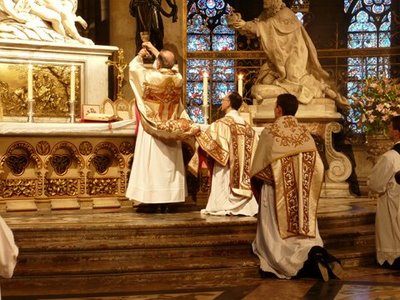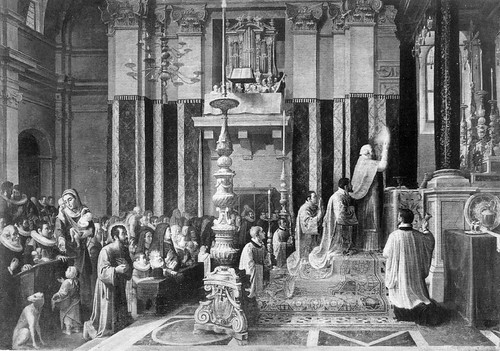


21. Liturgical practice begins with the very founding of the Church. The first Christians, in fact, "were persevering in the doctrine of the apostles and in the communication of the breaking of bread and in prayers."[23] Whenever their pastors can summon a little group of the faithful together, they set up an altar on which they proceed to offer the sacrifice, and around which are ranged all the other rites appropriate for the saving of souls and for the honor due to God. Among these latter rites, the first place is reserved for the sacraments, namely, the seven principal founts of salvation. There follows the celebration of the divine praises in which the faithful also join, obeying the behest of the Apostle Paul, "In all wisdom, teaching and admonishing one another in psalms, hymns and spiritual canticles, singing in grace in your hearts to God."[24] Next comes the reading of the Law, the prophets, the gospel and the apostolic epistles; and last of all the homily or sermon in which the official head of the congregation recalls and explains the practical bearing of the commandments of the divine Master and the chief events of His life, combining instruction with appropriate exhortation and illustration of the benefit of all his listeners.

22. As circumstances and the needs of Christians warrant, public worship is organized, developed and enriched by new rites, ceremonies and regulations, always with the single end in view, "that we may use these external signs to keep us alert, learn from them what distance we have come along the road, and by them be heartened to go on further with more eager step; for the effect will be more precious the warmer the affection which precedes it."[25] Here then is a better and more suitable way to raise the heart to God. Thenceforth the priesthood of Jesus Christ is a living and continuous reality through all the ages to the end of time, since the liturgy is nothing more nor less than the exercise of this priestly function. Like her divine Head, the Church is forever present in the midst of her children. She aids and exhorts them to holiness, so that they may one day return to the Father in heaven clothed in that beauteous raiment of the supernatural. To all who are born to life on earth she gives a second, supernatural kind of birth. She arms them with the Holy Spirit for the struggle against the implacable enemy. She gathers all Christians about her altars, inviting and urging them repeatedly to take part in the celebration of the Mass, feeding them with the Bread of angels to make them ever stronger. She purifies and consoles the hearts that sin has wounded and soiled. Solemnly she consecrates those whom God has called to the priestly ministry. She fortifies with new gifts of grace the chaste nupitals of those who are destined to found and bring up a Christian family. When as last she has soothed and refreshed the closing hours of this earthly life by holy Viaticum and extreme unction, with the utmost affection she accompanies the mortal remains of her children to the grave, lays them reverently to rest, and confides them to the protection of the cross, against the day when they will triumph over death and rise again. She has a further solemn blessing and invocation for those of her children who dedicate themselves to the service of God in the life of religious perfection. Finally, she extends to the souls in purgatory, who implore her intercession and her prayers, the helping hand which may lead them happily at last to eternal blessedness in heaven.

23. The worship rendered by the Church to God must be, in its entirety, interior as well as exterior. It is exterior because the nature of man as a composite of body and soul requires it to be so. Likewise, because divine Providence has disposed that "while we recognize God visibly, we may be drawn by Him to love of things unseen."[26] Every impulse of the human heart, besides, expresses itself naturally through the senses; and the worship of God, being the concern not merely of individuals but of the whole community of mankind, must therefore be social as well. This obviously it cannot be unless religious activity is also organized and manifested outwardly. Exterior worship, finally, reveals and emphasizes the unity of the mystical Body, feeds new fuel to its holy zeal, fortifies its energy, intensifies its action day by day: "for although the ceremonies themselves can claim no perfection or sanctity in their won right, they are, nevertheless, the outward acts of religion, designed to rouse the heart, like signals of a sort, to veneration of the sacred realities, and to raise the mind to meditation on the supernatural. They serve to foster piety, to kindle the flame of charity, to increase our faith and deepen our devotion. They provide instruction for simple folk, decoration for divine worship, continuity of religious practice. They make it possible to tell genuine Christians from their false or heretical counterparts."[27]

 inundado por um mistério de luz que é Deus e N´Ele vi e ouvi -A ponta da lança como chama que se desprende, toca o eixo da terra, – Ela estremece: montanhas, cidades, vilas e aldeias com os seus moradores são sepultados. - O mar, os rios e as nuvens saem dos seus limites, transbordam, inundam e arrastam consigo num redemoinho, moradias e gente em número que não se pode contar , é a purificação do mundo pelo pecado em que se mergulha. - O ódio, a ambição provocam a guerra destruidora! - Depois senti no palpitar acelerado do coração e no meu espírito o eco duma voz suave que dizia: – No tempo, uma só Fé, um só Batismo, uma só Igreja, Santa, Católica, Apostólica: - Na eternidade, o Céu!
inundado por um mistério de luz que é Deus e N´Ele vi e ouvi -A ponta da lança como chama que se desprende, toca o eixo da terra, – Ela estremece: montanhas, cidades, vilas e aldeias com os seus moradores são sepultados. - O mar, os rios e as nuvens saem dos seus limites, transbordam, inundam e arrastam consigo num redemoinho, moradias e gente em número que não se pode contar , é a purificação do mundo pelo pecado em que se mergulha. - O ódio, a ambição provocam a guerra destruidora! - Depois senti no palpitar acelerado do coração e no meu espírito o eco duma voz suave que dizia: – No tempo, uma só Fé, um só Batismo, uma só Igreja, Santa, Católica, Apostólica: - Na eternidade, o Céu!